Planting, growing and caring for one-clove garlic when digging and harvesting
One-clove garlic is a crop that is obtained by planting the finest air bulbs. For several years in a row, gardeners have been using a similar method of propagating garlic. Why exactly he? This helps not only to get a rich harvest, but also to renew it. This procedure is needed to keep the vegetable yield at a high level.
What is a one-toothed tooth?
Seed material, which is intended for obtaining one-tooth, is winter-hardy. It is practically not affected by diseases and various pests, in particular, nematodes. Gives a rich harvest, compared to the amount that is obtained as a result of planting ordinary cloves.
The puffed bulbs used to produce one-toothed are the size of barley or oats. They are small. The shape of some varieties may vary. Almost round or slightly oval teeth are found. In rare cases, they look like a pea.
How to grow garlic from air?
Planting garlic with air bulbs is carried out 2 times a year:
- spring is planted in early spring after the last frost;
- winter - a month before the onset of frost.
Winter garlic is planted in late September or mid-October. Air bulbs are laid in the ground in the standard way - in lowercase. There should be at least 20 cm between the rows. In order not to be mistaken, it is recommended to adhere to the following scheme - 45-50 teeth per running meter.

How to care for crops?
Crop maintenance should be regular. If the gardener has planted winter bulbs, the soil should be covered with a lot of snow. Not enough rainfall may fall during the winter. In this case, all the snow is shoveled into the beds. This approach will ensure that early seedlings are obtained.
Dry weather negatively affects seedling growth. If a person lives in a region with an arid climate, he must take care of thorough watering of the culture. The beds must be watered at least 1 time per month. Particular attention should be paid to watering in May.
Crops also need feeding. The fertilization procedure takes place in two stages. At the end of March and until the beginning of April, the soil is saturated with nitrophos. In the first week of June, the beds are sprinkled with wood ash and ammophos.
Planting one-tooth
One-toothed garlic is an ideal planting material. A large and strong culture grows out of it, which has many teeth. Plant slices root without problems and tolerate winter well. When to plant planting material?
The winter planting scheme is adhered to - late September-early October.
Before planting garlic, the planting material needs to be sorted. Size plays an important role in this matter. Depending on the size, garlic is divided into classes:
- the first - from 12 to 15 mm;
- the second - from 10 to 12 mm.

If the set is much smaller, it is no longer suitable for planting in the soil. The winter species should be planted immediately in 2–4 rows, keeping a distance of 40–45 cm. Garlic seeds are deepened by no more than 7 cm. After creating a hole, you need to pour 1 tbsp. a spoonful of sand and place the set on top. Then cover the pea with a small amount of the same sand.
Thanks to this approach, the garlic beds will be protected from wetting the soil and rotting crops. This is a kind of micro-drainage. As soon as the planting of the garlic is finished, a little compost is added to the holes and covered with earth. If arrows appear on seedlings, they must be removed. Moreover, do this as soon as those in length reach at least 5 cm.
The arrows are removed under the third sheet. If this is not done, the crop yield will significantly decrease.
Top dressing
One-toothed garlic, like other crops, needs feeding. Fertilizers are applied in several stages - late April, early May and early June. Special preparations nourish the plant, supplying it with the missing microelements. In spring and summer in dry climates, it is recommended to water the beds once a week.
When to collect the one-tooth?
Throughout the stage of development of the culture, it is necessary to monitor how the garlic grows. Especially, before harvesting, pay attention at the end of the growing season. Constant surveillance helps determine when to harvest garlic... Usually the harvesting period coincides with the beginning of the yellowing of the tips of the leaves. In addition, the feathers begin to lay down.
If a person cannot decide when to plant garlic in the soil, there should be no hesitation when digging. Harvesting the garlic is very fast. If you wait with this business, the feathers will dry out and will die off. At the same time, the bulb begins to go deeper into the soil, this affects the harvesting of the crop and leads to its reduction.
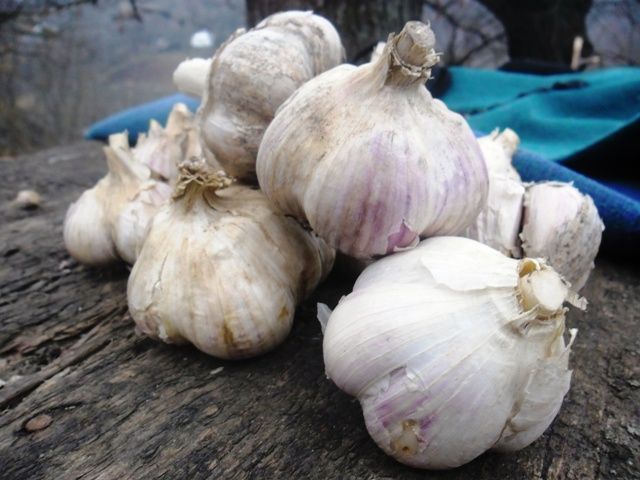
Tools for work
With one-tooth, grown on large land plots, proceed as follows - the roots are pruned using ordinary staples. After that, the culture is selected from the soil by hand. The dug garlic needs to be dried. To do this, he is transferred to a special room and left for several days.
When sevok is grown in a vegetable garden and small plots of land, the amount of work is reduced. It is recommended to dig the garlic from the ground with a shovel. As soon as it is completely knocked out of the ground, it is debugged to the side. In this position, the culture is left to dry completely.
Post-harvest work
The harvested garlic can be dried in several ways. Some varieties are left in the beds and, if necessary, covered with foil. Usually, an attic or shed is suitable for this venture. From the collected and well-dried cloves, the feather is torn off, which passes into the stem. Then they clean the ground and cut the roots, sort by size and set aside for further storage in a dry and ventilated room.
More about classes
Given the size of the garlic, it is determined to which class the vegetable belongs - to I or II. If the clove in terms of parameters approached the first class, in the further development the head will turn out to be normal. A smaller sevok forms an unusual bulb, and one large one without cloves. It is used as a planting material.
This approach makes it possible to obtain material for the propagation of valuable varieties. It can be stored for 2-3 years, without deteriorating the quality of the culture, but only increasing it. When planting winter crops and spring garlic adhere to the main recommendations.This allows you to get a large onion for further propagation and consumption.
One clove - garlic, which is a planting material that has technological advantages over a regular clove:
- It stands out for its round appearance. The size can change, but the shape is not. The usual teeth are elongated.

- The center of mass of one-clove garlic coincides with the center of the pea itself. The center of mass of the clove is displaced towards the bottom.
- The shape of a one-tooth is similar to a pea, therefore it allows calibration before planting.
- The planted seeds have a healthy immune system, so they do not succumb to the effects of parasites and vegetable diseases.
- It takes root without problems and tolerates winter.
- Garlic, which has grown from a single clove, is already harvesting the next year.
- A large onion does not need to be peeled.
- The yield of the one-tooth is much higher than the cloves of the same mass when planted.
Despite its many advantages, culture has disadvantages as well. Fortunately, there is only one - a higher price, due to the labor costs of growing, caring for and harvesting.
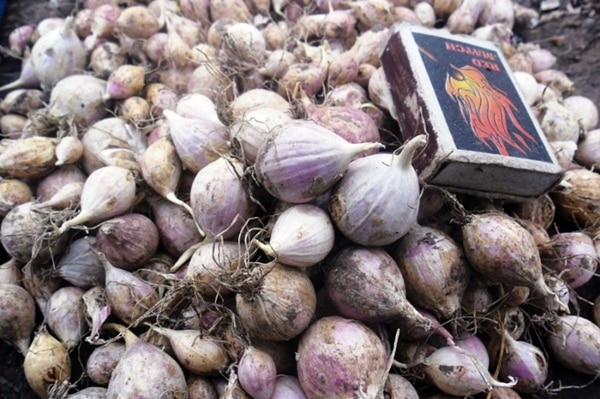
Important nuances
To get the maximum crop yield, take into account the interesting features of the planting material. If you dig up a one-tooth, it falls into a natural state of rest. This can be controlled using the temperature setting. If the crop begins to deteriorate, a person looks for reasons for this, without even thinking about the temperature. To ensure normal storage, the room should be between 5 and 10 ° C.
Failure to observe the temperature brings the culture out of dormancy.
The cultivation of one-toothed garlic is not the only important condition for harvesting. Enough attention is paid to the storage location. The room should be well ventilated, dry and cool. For storage, nets or boxes are used, which are placed on racks.
If the garlic has been grown according to all the rules, premature digging contributes to rapid drying. Among the total volume for storage, 2% of one-tooth with mechanical damage is allowed.
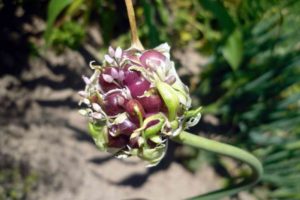
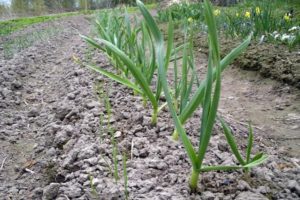
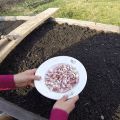

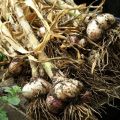
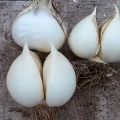

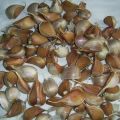


Another devastating thanks! Well, I did everything wrong! Starting with planting the cloves in the spring, this year I was also going to do the same. Moreover, I keep the cloves, which are just in a bag, together with other seeds, in the refrigerator, where the vegetables are. I will plant them anyway. But I don’t understand where I got the information that I need to plant in the spring? The main thing is already 10 years old. Just earlier and I didn’t know that the garlic needed to be renewed. It renewed itself when the chives were crumbling, I forgot to cut the arrows. Then I thought that it was growing, I understood by the smell and taste that the garlic was leaving. Only thanks to this it probably survived from me for so many years, only 10 years, she began to update purposefully. But it turns out again not.